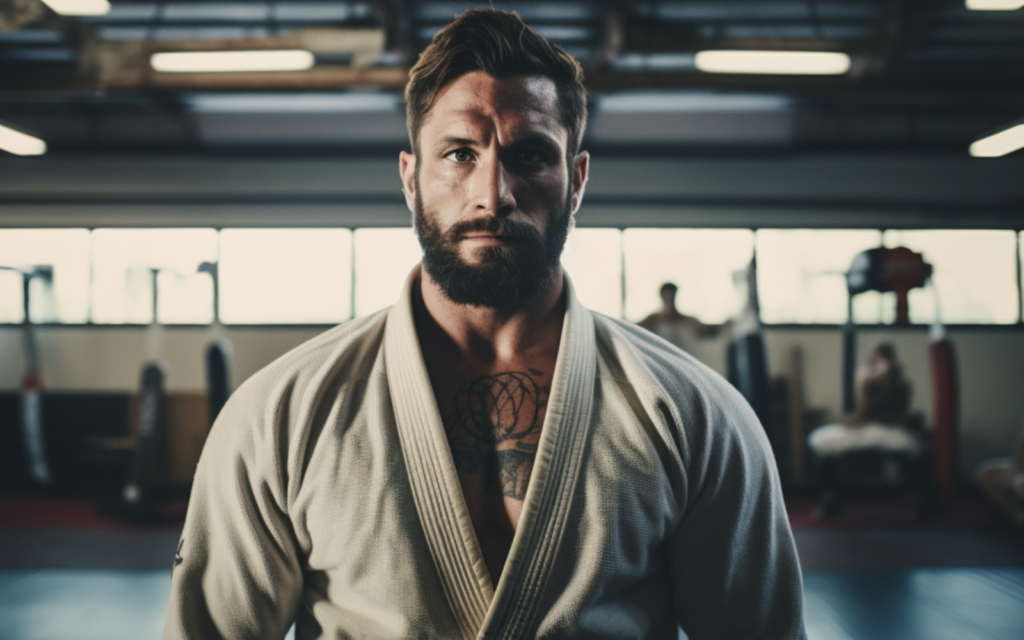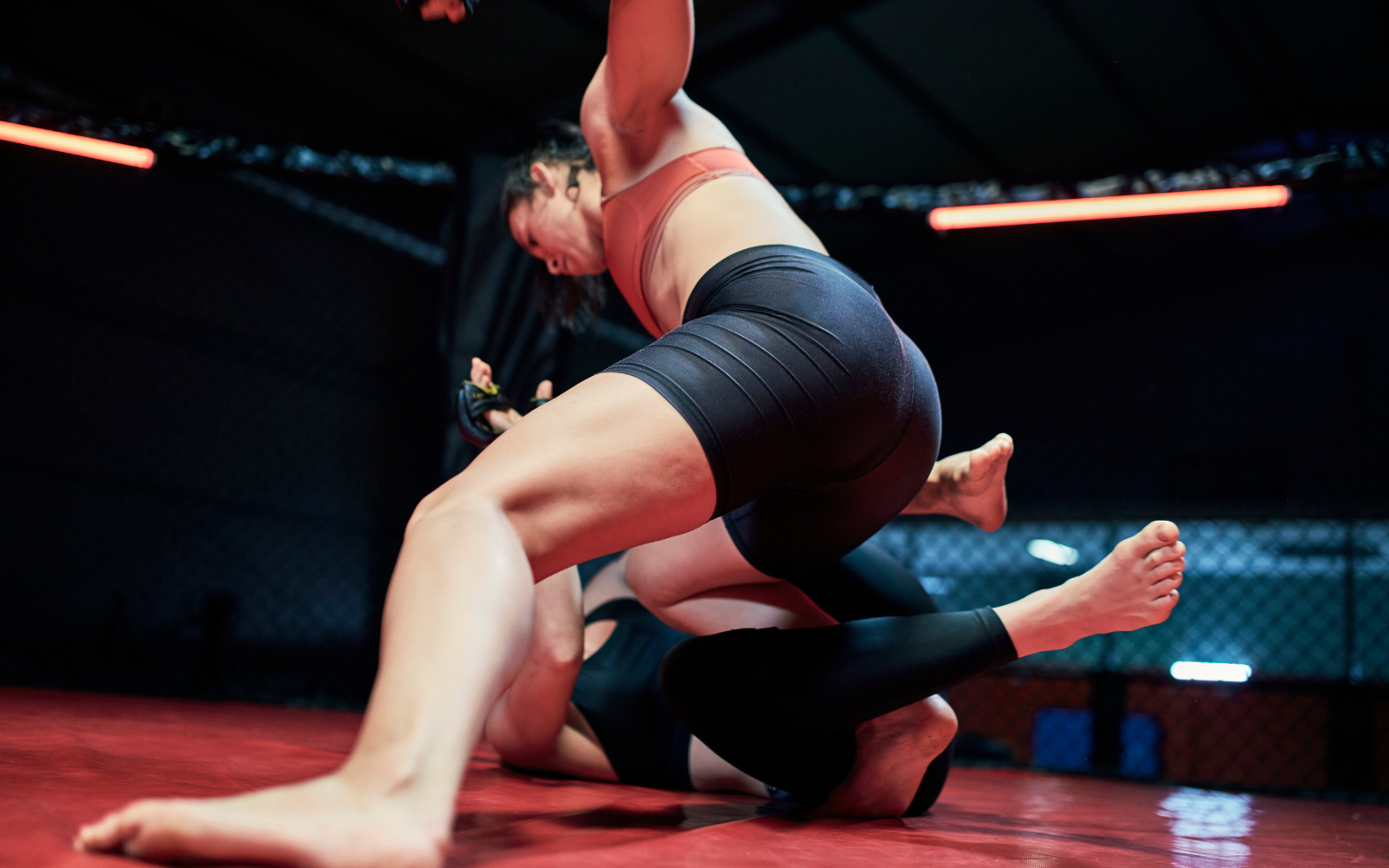Judo vs MMA is a collision of discipline, technique, and raw brute force.
These two combat arts are known around the world for being effective both for competition and for self-defense.
And in this article, we’re looking at both Judo vs MMA – their backgrounds, similarities, differences and their effectiveness in a street fight to determine which one reigns supreme.
Let’s go!
What is Judo?
To get things started, let’s look at Judo.
The Background of Judo

Judo is a Japanese martial art developed by Jigoro Kano in the late 1800s (19th Century). It’s a derivative of the Japanese old-style jiu-jitsu and has an emphasis on throws, joint locks, and ground control.
Judo epitomizes the philosophy of maximum efficiency with minimal effort, emphasizing respect, discipline, and continuous self-improvement.
Judo is a globally recognized sport, included in the Olympic Games since 1964, and continues to be a significant cultural ambassador for Japan.
Ranking System in Judo
Judo uses a belt system to denote the level of mastery, starting with colored belts for novices, progressing to black belts for those achieving a level of proficiency, and beyond that are various degrees represented by stripes.
It’s a key difference from many other
Learning and Training in Judo
Judo places a significant emphasis on form and technique.
For that reason, it requires substantial time and dedication during training sessions to understand and implement intricate throwing and ground techniques effectively.
Mastering techniques is both mentally and physically demanding. Practitioners find that Judo demands mental toughness and focus, and a growth mindset geared towards constant self-improvement.
Beyond the physical demands, Judo also instills a moral code which includes:
- Respect: Judo teaches respect for oneself, one’s opponent, and the instructor, emphasizing courtesy and humility.
- Discipline: Practitioners learn self-control and the value of hard work and consistent practice.
- Patience: Judo emphasizes the importance of patience in learning techniques and strategies and in overcoming challenges.
- Perseverance: Endurance and resilience are cultivated to overcome difficulties and continue striving for improvement.
- Focus: Concentration and mindfulness are developed to enhance learning and performance.
- Courage: Judo encourages facing fears and challenges with bravery.
- Politeness: Courtesy and good manners are integral values in judo, promoting harmonious relationships.
- Honor: Upholding one’s principles and maintaining integrity are central to judo’s philosophy.
- Modesty: Practitioners are encouraged to be humble and to avoid arrogance.
- Friendship: Judo fosters camaraderie and mutual support among practitioners.
Ultimately, Judo is not simply about learning self-defense techniques; it’s about striving for personal growth and building character.
Unraveling MMA
So now let’s look at the rival standing in the opposite corner: MMA.

The Emergence of MMA
MMA is a relatively new combat sport that really rose to prominence only in the late 1990s century with the advent of the UFC.
It stands out as a full-contact combat sport that integrates a wide range of techniques from various martial arts including boxing, Muay Thai, Brazilian Jiu-Jitsu, and even Judo.
And one unique aspect of MMA’s popularity is that its growth is worldwide is directly correlated to the popularity of high profile fighters like Conor McGregor, Georges Saint-Pierre, Anderson Silva, and Ronda Rousey.
MMA’s Approach to Ranking
One major difference between Judo and MMA is the lack of a universally adopted system in MMA.
Some MMA schools and martial arts studios might use belt systems similar to those in traditional martial arts, but it’s not a standardized or central aspect across the sport.
In contrast, MMA fighters often have backgrounds in multiple martial arts, each with their own ranking systems. This making a unified, standardized system across all of MMA.
So how to classify a fighter’s ability? MMA organizations and promotions typically classify fighters based on their win-loss fight records.
MMA’s Learning Curve
MMA is a fusion of various combat styles, allowing practitioners to develop a broader range and complete skill set.
The art form is more accessible initially, offering a comprehensive and intense workout, but mastering multiple disciplines and adapting to different fighting techniques can be quite challenging.
MMA training not only enhances physical strength and endurance but also sharpens mental agility and resilience.
The meticulous strategy planning, quick decision-making, and adaptability required in MMA matches foster discipline, focus, and patience.
To be proficient in MMA, one must also learn to balance aggression with restraint, power with precision, and confidence.
Unlike Judo, MMA has no formal moral code but follows a unified set of rules. And MMA fighters are encouraged to embrace principles like respect, discipline, honor, and sportsmanship.
Many MMA gyms embed values like humility, dedication, and respect in their training.
Rather than moral codes, MMA promotions and clubs enforce codes of conduct to maintain the sport’s integrity.
Judo vs MMA: A Comparative Analysis
Let’s dive a little deeper into how these two martial arts compare.
Philosophical and Technical Divergence
Judo and MMA share a foundation in combat but diverge significantly in their philosophies and emphasis on ground fighting.
Judo, with its emphasis on throws, such as the powerful hip throw, and ground control, is ideal for those seeking discipline and a structured learning environment.
MMA, on the other hand, emphasizes adaptability and the integration of a range of techniques, making it an excellent choice for those desiring versatility.
Additionally, the mindset and training environment also differ between Judo and MMA.
Judo is a traditional martial art and focuses on respect, discipline, and the acquisition of technique mastery. Its training environment is often rigorous and hierarchical, with strict adherence to etiquette and tradition.
But MMA has a more liberal, dynamic approach. MMA practitioners use creativity and individualism, and incorporate techniques from various martial arts to adapt and demolish an opponent.
The training environment in MMA is usually more relaxed and informal, promoting a sense of camaraderie and mutual respect among fighters.
Judo vs MMA for Self-defense

So now the big question: Which one wins in a real fight?
In terms of real fight effectiveness, both Judo, with its emphasis on ground position and ability to turn an opponent into submission, and MMA, with its versatile and eclectic approach, offer valuable skills.
Fighters like Royce Gracie, who won UFC 1, have showcased the effectiveness of grappling-based martial arts against heavier and stronger opponents.
But the effectiveness of these martial arts can vary depending on the circumstances of the combat situation.
Judo is highly effective in one-on-one combat. Its techniques can neutralize a stronger opponent and turn the tables in your favor.
But in a situation where you face off against multiple attackers, Judo’s techniques become a disadvantage and can put you at risk.
Training MMA gives you a more well-rounded skill set for self-defense, and includes elements from various martial arts like boxing, jiu-jitsu, wrestling, and Muay Thai.
This mix gives you a wider array of techniques to draw from in a combat situation.
An MMA-trained fighter can strike and defend from various ranges, grapple effectively, and has the ability to adapt to different fighting styles.
But it’s important to remember that real-life combat is unpredictable and chaotic, and no martial art can guarantee safety in every situation.
Situational awareness and understanding of self-defense principles are crucial.
MMA/UFC Fighters With Judo Background
There are many high-profile UFC fighters with a background in Judo.
Ronda Rousey: Rousey is one of the most famous UFC fighters with a background in Judo. She won a bronze medal in Judo at the 2008 Olympics and was the first woman to win a UFC Championship.
Karo Parisyan: Parisyan is a former UFC contender who was known for his Judo throws and submissions in the Octagon.
Hector Lombard: Lombard is a former Olympic Judoka who competed for Cuba in the 2000 Olympics. He later transitioned to MMA and fought in the UFC middleweight and welterweight divisions.
Dong Hyun Kim: Kim is a South Korean UFC fighter who has a fourth-degree black belt in Judo.
Yoshihiro Akiyama: Akiyama is a Japanese UFC fighter who has a background in both Judo and K-1. He won a gold medal in Judo at the 2002 Asian Games.
Satoshi Ishii: Ishii is a Japanese Judoka who won a gold medal in Judo at the 2008 Olympics. He later transitioned to MMA and fought in various promotions including the UFC.
Rick Hawn: Hawn is a former Olympic Judoka who competed for the United States in the 2004 Olympics. He later transitioned to MMA and fought in various promotions including Bellator.
Daniel Kelly: Kelly is an Australian UFC fighter who has a fourth-degree black belt in Judo. And he competed in four Olympic Games for Australia in Judo.
In Conclusion: Judo vs MMA
In a showdown of Judo vs MMA, both are excellent self-defense martial arts, providing different approaches to combat and self-improvement.
The inherent risk of injury exists in both, but the choice between them hinges on an individual’s preference for structure, discipline, range, and styles.
From a strictly functional standpoint, MMA is more effective.
But if you want a balance of personal development, values and practicality, Judo edges out MMA.
Regardless of the choice made, the journey in either martial art form requires resilience, dedication, and a relentless pursuit of knowledge and skill enhancement.
